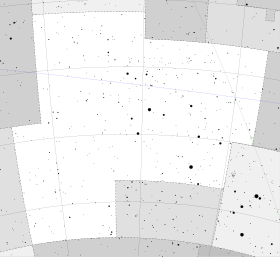HR 7703
| Observation data EpochJ2000EquinoxJ2000 | |
|---|---|
| Constellation | Sagittarius |
| Right ascension | 20h11m11.93827s[1] |
| Declination | –36° 06′ 04.3610″[1] |
| Apparent magnitude(V) | 5.31[2]/11.50[3] |
| Characteristics | |
| Spectral type | K2.5 V[4]+ M4 V[5] |
| U−Bcolor index | +0.43[2] |
| B−Vcolor index | +0.85[2] |
| Astrometry | |
| Radial velocity(Rv) | –129.4[6]km/s |
| Proper motion(μ) | RA:+456.99[1]mas/yr Dec.:–1574.64[1]mas/yr |
| Parallax(π) | 166.3272 ± 0.1065mas[7] |
| Distance | 19.61 ± 0.01ly (6.012 ± 0.004pc) |
| Absolute magnitude(MV) | 6.53[8] |
| Details | |
| HR 7703 A | |
| Mass | 0.65[9]M☉ |
| Radius | 0.66[9]R☉ |
| Luminosity | 0.26[9]L☉ |
| Surface gravity(logg) | 4.48 ± 0.17[9]cgs |
| Temperature | 5,075 ± 43[9]K |
| Metallicity[Fe/H] | –0.56 ± 0.04[9]dex |
| Rotational velocity(vsini) | 1.8 ± 0.2[8]km/s |
| Age | 7.7[10]Gyr |
| HR 7703 B | |
| Mass | 0.24[11]M☉ |
| Radius | 0.28[3]R☉ |
| Other designations | |
| HR 7703 A:LHS486,LFT1529,LTT7988 | |
| HR 7703 B:LHS 487, LFT 1530, LTT 7989 | |
| Database references | |
| SIMBAD | The system |
| A | |
| B | |
Location of HR 7703 in the constellationSagittarius | |
HR 7703(Gliese 783, 279 G. Sagittarii) is abinary starsystem in theconstellationofSagittarius.The brighter component has anapparent visual magnitudeof 5.31,[2]which means it isvisible from suburban skiesat night. The two stars are separated by an angle of 7.10″, which corresponds to an estimatedsemimajor axisof 56.30AUfor their orbit.[11]
Based upon an annualparallaxshift of 0.16625arc secondsas measured by theHipparcossatellite, this system is 19.62light-years(6.015parsecs) fromEarth.It is approaching theSolar Systemat avelocityof approximately 129 kilometers per second.[6]At this rate, it will make its closest approach in 41,100 years when it comes to within 6.7 light-years (2.05 parsecs) of the Sun.[13]
This star system has been examined for anexcess of radiationin theinfrared.The presence of an infrared excess can be taken as an indication of adebris diskorbiting the star. However, no such excess was discovered around HR 7703.[14]Radial velocitydata collected over a period of 12 years was examined for signs of periodicity caused by a planet orbiting at a distance of 3–6AU,but none was detected.[15]A slight linear trend in the radial velocities of the primary is probably due to the companion star.[16]
References
[edit]- ^abcdvan Leeuwen, F. (November 2007), "Validation of the new Hipparcos reduction",Astronomy and Astrophysics,474(2): 653–664,arXiv:0708.1752,Bibcode:2007A&A...474..653V,doi:10.1051/0004-6361:20078357,S2CID18759600.
- ^abcdFeinstein, A. (1966), "Photoelectric observations of Southern late-type stars",The Information Bulletin for the Southern Hemisphere,8:30,Bibcode:1966IBSH....8...30F.
- ^abPasinetti-Fracassini, L. E.; et al. (February 2001), "Catalogue of Stellar Diameters (CADARS)",Astronomy and Astrophysics,367:521–524,arXiv:astro-ph/0012289,Bibcode:2001A&A...367..521P,doi:10.1051/0004-6361:20000451,S2CID425754.
- ^Gray, R. O.; et al. (July 2006), "Contributions to the Nearby Stars (NStars) Project: Spectroscopy of Stars Earlier than M0 within 40 parsecs: The Northern Sample I",The Astronomical Journal,132(1): 161–170,arXiv:astro-ph/0603770,Bibcode:2006AJ....132..161G,doi:10.1086/504637,S2CID119476992.
- ^Turnbull, Margaret C.;Tarter, Jill C.(December 2003), "Target Selection for SETI. II. Tycho-2 Dwarfs, Old Open Clusters, and the Nearest 100 Stars",The Astrophysical Journal Supplement Series,149(2): 423–436,Bibcode:2003ApJS..149..423T,doi:10.1086/379320.
- ^abNordström, B.; et al. (May 2004), "The Geneva-Copenhagen survey of the Solar neighbourhood. Ages, metallicities, and kinematic properties of ˜14 000 F and G dwarfs",Astronomy and Astrophysics,418(3): 989–1019,arXiv:astro-ph/0405198,Bibcode:2004A&A...418..989N,doi:10.1051/0004-6361:20035959,S2CID11027621.
- ^Brown, A. G. A.;et al. (Gaia collaboration) (2021)."GaiaEarly Data Release 3: Summary of the contents and survey properties ".Astronomy & Astrophysics.649:A1.arXiv:2012.01533.Bibcode:2021A&A...649A...1G.doi:10.1051/0004-6361/202039657.S2CID227254300.(Erratum:doi:10.1051/0004-6361/202039657e).Gaia EDR3 record for this sourceatVizieR.
- ^abAmmler-von Eiff, Matthias; Reiners, Ansgar (June 2012), "New measurements of rotation and differential rotation in A-F stars: are there two populations of differentially rotating stars?",Astronomy & Astrophysics,542:A116,arXiv:1204.2459,Bibcode:2012A&A...542A.116A,doi:10.1051/0004-6361/201118724,S2CID53666672.
- ^abcdefGhezzi, L.; et al. (September 2010), "Stellar Parameters and Metallicities of Stars Hosting Jovian and Neptunian Mass Planets: A Possible Dependence of Planetary Mass on Metallicity",The Astrophysical Journal,720(2): 1290–1302,arXiv:1007.2681,Bibcode:2010ApJ...720.1290G,doi:10.1088/0004-637X/720/2/1290,S2CID118565025.
- ^Mamajek, Eric E.; Hillenbrand, Lynne A. (November 2008), "Improved Age Estimation for Solar-Type Dwarfs Using Activity-Rotation Diagnostics",The Astrophysical Journal,687(2): 1264–1293,arXiv:0807.1686,Bibcode:2008ApJ...687.1264M,doi:10.1086/591785,S2CID27151456.
- ^abBonavita, M.; Desidera, S. (June 2007), "The frequency of planets in multiple systems",Astronomy and Astrophysics,468(2): 721–729,arXiv:astro-ph/0703754,Bibcode:2007A&A...468..721B,doi:10.1051/0004-6361:20066671,S2CID18907128.
- ^"HD 191408".SIMBAD.Centre de données astronomiques de Strasbourg.Retrieved2014-01-10.
- ^Bobylev, Vadim V. (March 2010), "Searching for Stars Closely Encountering with the Solar System",Astronomy Letters,36(3): 220–226,arXiv:1003.2160,Bibcode:2010AstL...36..220B,doi:10.1134/S1063773710030060,S2CID118374161.
- ^Trilling, D. E.; et al. (February 2008), "Debris Disks around Sun-like Stars",The Astrophysical Journal,674(2): 1086–1105,arXiv:0710.5498,Bibcode:2008ApJ...674.1086T,doi:10.1086/525514,S2CID54940779.
- ^Wittenmyer, Robert A.; et al. (February 2011), "On the Frequency of Jupiter Analogs",The Astrophysical Journal,727(2): 102,arXiv:1011.4720,Bibcode:2011ApJ...727..102W,doi:10.1088/0004-637X/727/2/102,S2CID56204861.
- ^Howard, Andrew W.; Fulton, Benjamin J. (2016). "Limits on Planetary Companions from Doppler Surveys of Nearby Stars".Publications of the Astronomical Society of the Pacific.128(969). 114401.arXiv:1606.03134.Bibcode:2016PASP..128k4401H.doi:10.1088/1538-3873/128/969/114401.S2CID118503912.
External links
[edit]- Indus and Pavo
- "J. Herschel 5173 AB",SolStation,retrievedNovember 6,2005

